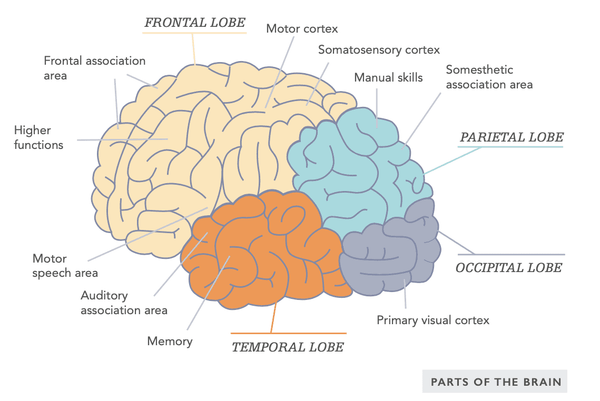Meditation, HIIT, listening to music, yoga, barefoot running and tDCS. What have these ailments in common? They all improve working memory! Find out more from this article!
As its name implies, working memory represents the information storage currently in use for work or other activities. It is activated when the individual is making deductions, thinking, studying, solving problems, or retrieving information from long-term memory for immediate use. Working memory is also essential to the decision-making process. Working memory can be divided into verbal and nonverbal (visuospatial) working memory based on the content processed.
Brain scans have made it possible to study the anatomy and physiology of memory functions. Working memory function is believed to take place mainly in the dorsolateral (processing of memorized information) and ventrolateral (maintenance of memorized information) areas of the prefrontal cortex. However, it is not restricted to just these areas – many studies indicate that working memory function also occurs in the cerebral cortex. It has been shown that working memory involving verbal functions and remembering objects predominantly activates the left side of the brain whereas spatial coordination predominantly activates the right side.

According to an American psychologist George Miller (1920– 2012), the capacity of working memory is estimated to be between 5 and 9 information chunks (the average being seven). More recently, it has been claimed that the real figure is between three to five (average being four information chunks), which is currently considered to be the most precise estimate of the capacity of working memory. The duration of working memory is estimated to be less than 20 seconds. However, it is possible to extend this time by repeating the items to be memorized.
Studies suggest that the neurotransmitters crucial for working memory function are dopamine, noradrenaline, and acetylcholine. Excessive or insufficient production of these neurotransmitters impairs the function of the prefrontal brain and, in particular, the dynamic network connectivity (DNC). Conducting working memory exercises has been found to increase the number of dopamine receptors (DRD1) in the prefrontal cortex and temporal lobe, which could be a factor behind enhanced memory function resulting from these exercises.
MEDITATION
Working memory functions are supported by inhibitory control which helps maintain concentration and prevents humans from reacting to all stimuli and thoughts present. Inhibitory control is a crucial factor in the ability to focus on a single matter at hand when the ability to block inner and outer distractions is necessary. For example, meditating has been found to curb wandering thoughts and to improve concentration.
TRANSCRANIAL DIRECT-CURRENT STIMULATION (TDCS)
Working memory activates various circuits depending on the task at hand. Focusing one's attention on something specific also activates various areas of the brain. For example, when one concentrates on something particularly important, this activates the left and right posterior parietal cortex, the ventromedial prefrontal cortex, and the left inferior parietal lobule of the brain. Transcranial direct-current stimulation (tDCS) of these areas may improve working memory.
TONAL (HARMONIOUS) MUSIC
Listening to tonal (harmonious) music, for example, fast classical music in a major key activates working memory and boosts processing speed particularly in the elderly. A study found that working memory capacity was related to (i.e., positively correlated with) one’s ability to learn with background music regardless of the music (classical or pop music conditions used in the study. Then again, some studies suggest that the working memory-boosting effect of binaural beats could be due to the brain’s response to beat frequency. The frequency may support the synchronization of cortical oscillations, areas important for cognitive functions, and retention of information in the working memory. We advise you to self-experiment what kind of music (if any) and sounds work for you in boosting working memory function.
YOGA
Movement-based and embodied practices such as yoga may support working memory function. A study found significantly enhanced working memory functions (especially executive functions) and efficiency in shifting between tasks in the yoga intervention group compared to the strength training group (active control) following an 8-week intervention. However, the underlying mechanisms behind this effect need further investigation to determine how practicing yoga supports working memory and other cognitive functions.
BAREFOOT RUNNING
Barefoot running may have cognition boosting benefits. A study compared working memory performance between two groups of young adults (barefoot runners & active control group with shoes) in two conditions (stepping on targets & no targets). Those who ran barefoot outperformed the control group in cognitive tasks after the stepping on targets condition. Researchers hypothesized that this effect could be due to the additional attention needed in the barefoot running to avoid injury (e.g., stepping on objects). Timewise, it is estimated that 16+ minutes could be enough to gain enhanced working memory function afterward. So, next time you go for a run, try something else and leave the shoes at home! This might feel awkward at first and you should proceed with caution. Once you progress, barefoot running becomes more comfortable and you will definitely see the benefits fast.
HIGH-INTENSITY MAXIMAL OR INTERVAL TRAINING
High-intensity maximal or interval training can support the learning process - especially during the four hours immediately post-training. A study found that short-term maximal aerobic exercise (until exhaustion) can boost working memory, attention ( e.g., continual processing), simple reaction time, and short-term memory (e.g., code substitution) among healthy young women. This effect is both immediate and develops over time with repetition. Read more from Biohacker’s Handbook!
What’s your top tip for supporting working memory function? Tell us in the comments!




